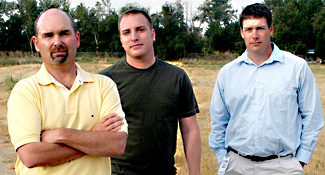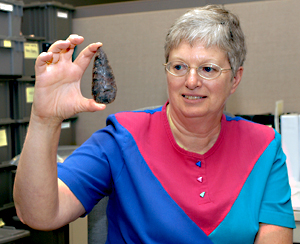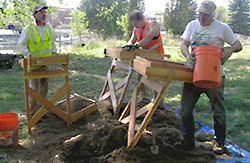
|
CONNECTIONS
|
IDAHO
ITD
HOME
IDAHO DMV
ITD
NEWS
HIGHWAY
SAFETY
IDAHO STATE
POLICE
TRAVEL SERVICES
STATE OF IDAHO
NATIONAL
AASHTO
AAMVA
AAA of IDAHO
FEDERAL HIGHWAYS
FEDERAL AVIATION
IDAHO STATE POLICE
NHTSA
NTSB
TRB
U.S. DOT
Idaho
Transportation
Department
Public Affairs Office
P.O. Box 7129
Boise, ID 83707
208.334.8005
Fax: 208.334.8563
Email

Cultural resources unit unearths Idaho history

Before workers and heavy equipment begin carving out the Sand Creek Byway route in Sandpoint, archaeologists will have to complete one of the largest testing and data recovery projects ITD has ever undertaken.
The Byway will be built at a junction once used by Native Americans traveling to Montana in search of buffalo or northward to the Kootenay area of Canada. The area also was the site of a construction camp for the Northern Pacific Railroad in the 1880s.
The Sandpoint project is physically one of the largest archaeological sites that ITD has overseen.
“Old documents and artifacts show that at the turn of the (20th) century the area was home to a Chinese immigrant labor camp, a bordello and a blacksmith shop,” said Dan Gard, ITD state highway archaeologist. “It’s actually part of the original Sandpoint town site.”
Cultural resource consultants started initial testing at the site in early June to help identify what to mitigate, or recover. Based on the results of that testing artifact recovery should begin this fall.
Gard, along with Marc Munch, transportation archaeologist; Dan Everhart, architectural historian; and RuthAnn Smith, curation specialist, comprise ITD’s Cultural Resources unit, whose purpose is to make certain that “we (ITD) assess the effects of our actions on cultural resources.”
 “Ninety-nine
percent of the resources we deal with are historical in nature,”
Gard said.
“Ninety-nine
percent of the resources we deal with are historical in nature,”
Gard said.
Section 106 of the National Historic Preservation Act requires a review of all actions that may affect a property currently listed on the National Register of Historic Places, or may affect a property that may be eligible for listing.
“You have to look at cultural resources that are more than 50 years old in order to see if they might meet specific criterion that make them eligible for the National Register,” Gard said. “Cultural resources can include buildings, canals, bridges, even old roads, as well as prehistoric sites.”
No small task for a group overseeing from 50-75 projects statewide in various stages of initial survey and, in some cases, the testing and data recovery phase. And it’s not slowing down. An increasing number of projects requires the use of consultants for field surveys that ITD used to conduct exclusively.
“If time allows, we still go out and conduct survey work for the districts,” Gard said. “It’s fun. It’s nice when we can get out in the field. We each have our own niche in terms of expertise, but we work on projects as a team.”
 “We’ve
saved ITD a considerable amount of money on projects requiring cultural
resources survey,” he said, adding that an outside consultant
hired to survey a two-acre site can cost several thousand dollars. “The
price goes up if the site requires mitigation,” he said.
“We’ve
saved ITD a considerable amount of money on projects requiring cultural
resources survey,” he said, adding that an outside consultant
hired to survey a two-acre site can cost several thousand dollars. “The
price goes up if the site requires mitigation,” he said.
Archaeologists perform site testing or surveying using several techniques:
-
A field survey consists of walking a pre-defined area at the site while looking for surface artifacts. In addition, records at the Idaho State Historic Preservation Office (SHPO), are studied to see if anyone has previously recorded historic or prehistoric resources in the area.
-
Depending on the results of the surface survey, shovel test units (STUs) or auger probes can be used to determine if artifacts are located underground and to provide a general site boundary.
-
If the site is determined eligible for the National Register and will be impacted by a proposed project, full scale mitigation may be required. Mitigation normally consists of removing the artifacts by digging one-meter by one-meter squares, or units, in 10-centimeter levels and meticulously documenting the artifacts and their exact location.
-
In rare instances, such as the Sandpoint project, vibracore testing is used for sampling cultural resources located underwater. Vibracore testing involves inserting a hollow metal tube into lake or creek bottom sediments and removing a core sample for analysis.
Once retrieved, artifacts are cleaned, sorted, labeled, catalogued, documented, and prepared for long-term storage at one of three regional repositories that together form the Archaeological Survey of Idaho (ASI).
“ITD shows good stewardship by working to protect cultural resources,” Gard said.
“Everything we do is for a reason,” he said. “The laws we follow are triggered by some federal connection to an ITD undertaking. Even on state projects without federal funding we essentially follow the same steps.”
The steps include conducting a cultural resources survey of a project’s effects on a specific area. This usually is part of the overall environmental assessment. If the survey shows that cultural resources in an area will be affected, ITD must mitigate the effects of their project actions. In most cases consultants are brought in to remove any artifacts that are in the way of the project. Finally, the results of the artifact recovery are made available to the public.
To accomplish this, ITD archaeologists work two or more
years in front of projects.
Among the more unusual finds were a group of dendroglyphs, or carved
trees, in the Stanley Basin. “We surveyed in an Aspen grove where
we found names, dates and drawings from the 1940s that were likely carved
by Basque sheepherders,” Gard said.
“Archaeologists find some of the most interesting stuff in odd places, such as old, abandoned outhouses,” he said. “They can be a treasure trove because a lot of things, such as used or broken household items, were often dumped in them.”
Photos: (left to right, top photo)
Dan Gard, Dan Everhart and Marc Munch oversee ITD cultural resource
projects statewide in various stages of survey, testing and recovery;
(middle photo) Curation Specialist RuthAnn Smith prepares recovered
artifacts for a new home in one of the Archaeological Survey of Idaho’s
three regional repositories; (bottom photo) Consultants conduct a cultural
resources survey for ITD along the Sand Creek Byway route.
Published 9-15-06